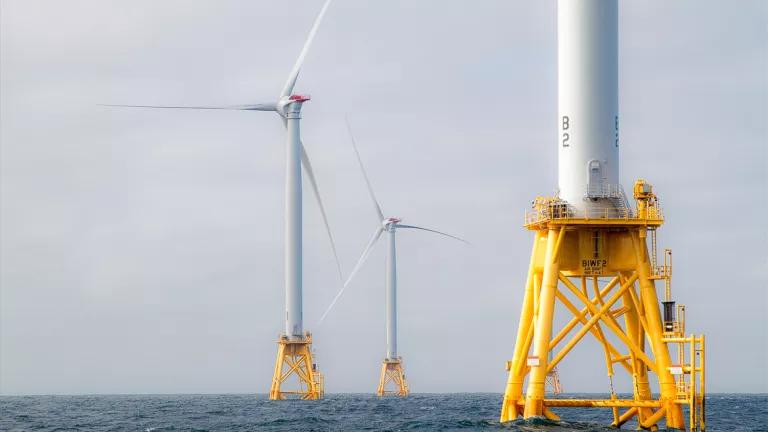Getting US Over Halfway to Net Zero by End of this Decade
Cutting U.S. emissions by at least half by decade’s end is ambitious, achievable, and necessary. It also requires deliberate actions to ensure an equitable transition.

President Biden has made a bold commitment as part of his assertive climate agenda to cut U.S. greenhouse gas emissions 50-52 percent below 2005 levels by 2030—doubling the current U.S. climate targets. With this announcement, the Biden administration sends a clear signal of a sharp break from the last four years of climate backsliding toward a strong new U.S. commitment to fight climate change under the Paris Agreement. Driving this level of ambition is the minimum that the moment requires. Cutting U.S. emissions by 50-52 percent by decade’s end is ambitious, achievable, and necessary. With deliberate actions to ensure an equitable transition, delivering on this target can make the lives of Americans better and will help mobilize the world to tackle the growing danger of the climate crisis.
Cutting Emissions Over Half by 2030 will Benefit Americans
Achieving equitable reductions in heat-trapping emissions of 50-52 percent compared to 2005 levels by 2030 will improve health, create jobs, spur economic growth, and help put the U.S. on a path towards staving off the worst impacts of climate change.
Put millions of Americans to work every year. More than 3 million Americans across every state and nearly every county are already at work in the clean energy economy. Achieving a 50-52 percent cut by 2030 could create more than 3 million job-years annually by 2030. This includes investing in more resilient and equitable infrastructure, workforce development training, making it easier to unionize, and ensuring opportunity to enter the clean energy sector for small scale entrepreneurs. Done right, this could create good-paying union jobs and new opportunities for inclusive economic growth to spur American innovation in the burgeoning clean energy economy.
Save lives and improve health. Cutting emissions more than in half would avoid more than 40,000 premature deaths this decade. Halving emissions would also deliver more than $150 billion in public health and environmental benefits just from cuts in the power sector. With smart policies, these benefits could address the cumulative impacts and environmental injustice that disproportionately harm people of color and low-income communities, further exacerbated by climate change.
Drive economic growth. Cutting emissions in half this decade can increase the U.S. gross domestic product by more than $500 billion per year in 2030. Any costs are more than offset with the economic value of those health, climate and other benefits.
Help ward off a climate catastrophe. Americans already suffer massive risks to life, limb, and property from wildfires, hurricanes, and other extreme weather events, which will only get worse if we don’t tackle the climate crisis. Cutting climate pollution 50-52 percent by 2030 is a critical step to help avoid the worst impacts that come if global temperatures rises above 1.5°C (2.7°F). It will help put the U.S. on a path towards net zero emissions no later than 2050 and help mobilize global action commensurate to the challenge.
Achieving this Level of Emissions Cut in the US is Achievable
Almost a dozen studies (including some not yet public) show that emissions can be cut at least in half by 2030 using known technologies and policy pathways. These findings are robust given the multiple analysis and different strategies to achieve such an emission cut. This is evident in the multiple assessments including by the Natural Resources Defense Council (NRDC), the University of Maryland Center for Global Sustainability, Environmental Defense Fund, Energy Innovation, America Is All In, America's Pledge, MIT, and Berkeley Labs. Each analysis came at this issue from a different angle, but they each concluded that such a target is achievable given the market, policy, and economic trends.
The U.S. has the tools to deliver on its target through a combination of standards and incentives. It will require a concerted and ambitious effort. It won’t be easy, but it is achievable.
Delivering on this target will require:
- Standards and investment programs to transition the power sector to 80 percent clean by 2030.
- Standards and incentives to achieve 55 percent of sales of new cars and trucks that are zero emissions by 2030.
- Incentives and standards to support building efficiency, expanding efficiency and electrification in industry, plus robust regulations for activities on federal land, expansion of nature-based solutions, and cuts in methane and HFCs.
- Dedicated resources to ensure reaching the target doesn’t over burden families and communities that can least afford it and are most vulnerable to the stresses of transition and the potential impacts of climate change.
- Ensuring policy alignment between the 2030 target and the sectoral policies (in housing, transportation, agriculture, health, and energy) required to achieve it in an equitable manner.
- Capacity building to ensure various institutions, regions and communities can respond and participate effectively in the transition with specific attention to struggling regions.
- Enhanced data that is disaggregated to highlight potential inequities at national and local scales to monitor and track progress and ensure that this data is fully integrated into sectoral policies and strategies.
Cutting emissions to this level will require the massive mobilization of America but achieving this level of cut doesn’t rely on wishful thinking or miracle technologies. We have the technologies and policy tools to achieve this target.
Action at this Scale Can Help Mobilize Greater Global Climate Action
The international community has persevered under the Paris Agreement while the prior U.S. administration marched in the opposite direction. Now, American global leadership is an essential element to mobilize more aggressive action at the required scale and pace. Recognizing that the U.S. must act aggressively at home while also driving faster global action, President Biden launched a reinvigorated climate agenda in his first week in office, placing climate change as a key priority for the domestic agenda and as a central organizing principle of America’s foreign policy.
The U.S. must use its various tools to help rally the world to a net zero emissions future no later than 2050. The administration has taken a strong first step with its goal to cut emissions 50-52 percent by the end of this decade.
Setting a target to cut emissions 50-52 percent below 2005 levels by 2030, and delivering the necessary actions, sets the conditions for the U.S. to help rally the world. This will need to be combined with the mobilization of significant finance to support developing countries in shifting towards a net zero economy and addressing the impacts of climate change.
We are already seeing growing pressure on countries to set bold targets to show their urgency. There is mounting pressure on Japan, Canada, and South Korea to commit to be halfway to net zero by the end of this decade—a 50 percent club—to show they are serious about tackling the climate crisis. Combined with the leadership of the European Union and United Kingdom, these countries can help marshal other countries to take more decisive action this decade.
Mobilizing for Action in the Decisive Decade
President Biden’s commitment to cut U.S. emissions 50-52 percent below 2005 levels by 2030—doubling the U.S. current effort—is a strong sign that the U.S. will help drive stronger climate action at home and abroad. It is just the beginning as this commitment will need to be delivered and strengthened over time if we are to make this the “decisive decade” in our effort to tackle the climate crisis.
Delivering on this target will create more jobs, protect more people, make our communities more livable, and help tackle the climate crisis. It will help the world rise to the challenge and catalyze stronger action in the days, weeks, and months ahead from the world’s largest emitting countries, companies, and sectors.
It won’t be easy. But it is necessary and achievable. It will benefit Americans and the world. And, really, we have no choice. The future is on the line.




